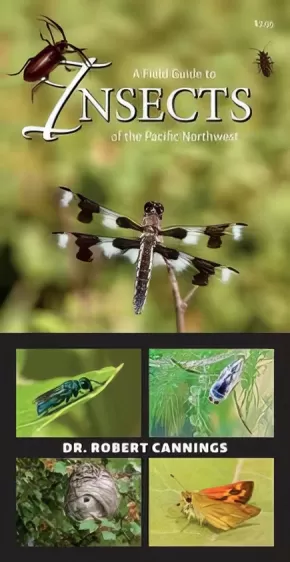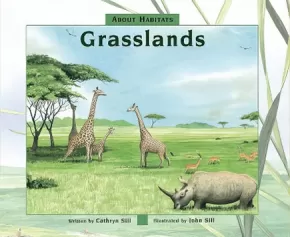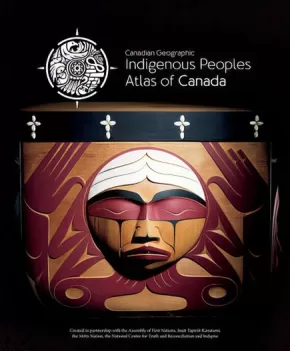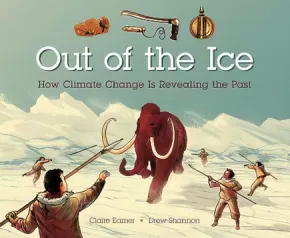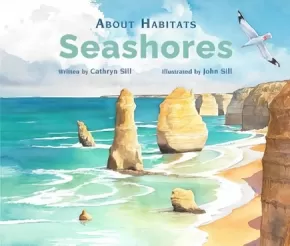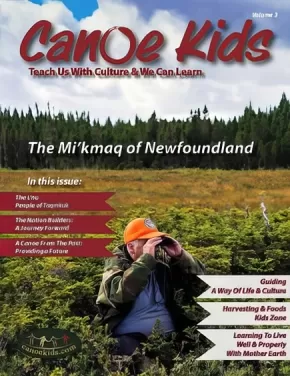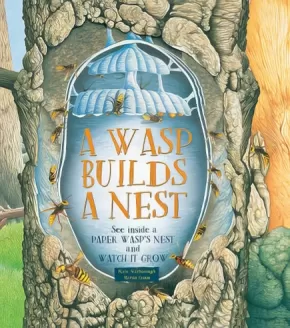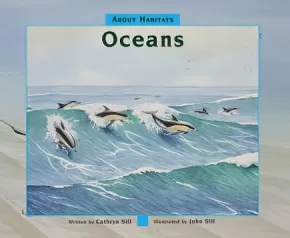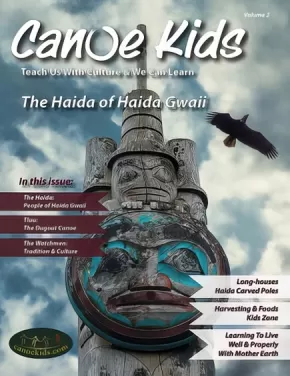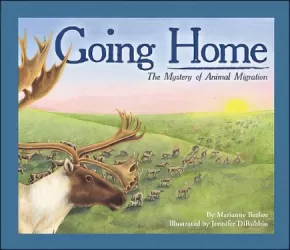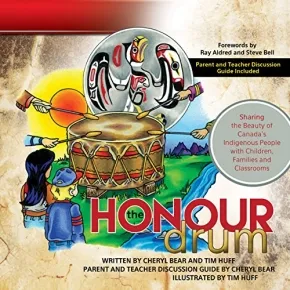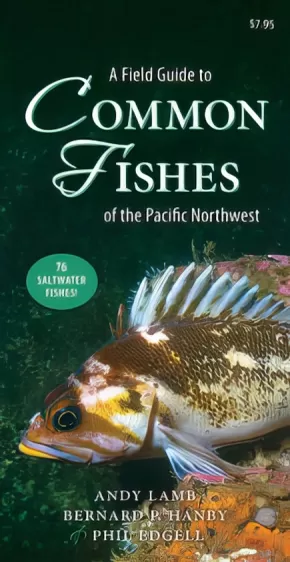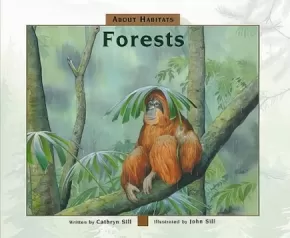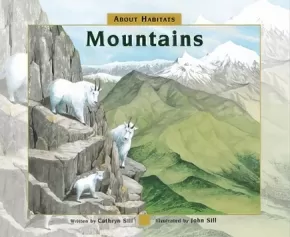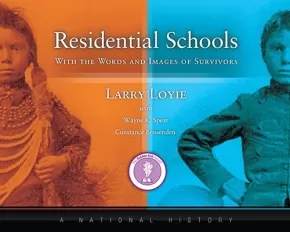
Reference
31
-
45
of
55 Results;
Sort By
Go To
of 4
A Field Guide to Insects of the Pacific Northwest
$8.95
Format:
Pamphlet
Reading Level: N/A
ISBN / Barcode: 9781550178340
Synopsis:
Synopsis:
Insects are all around us, from the butterflies in our gardens to the mosquitoes in the woods. About 80 percent of the 1.5 million named species of animals on earth are insects. Without flower-loving bees, wasps, flies and beetles, most crops and wild plants would not be pollinated and would disappear.
But insect diversity is largely invisible because most insects are small and difficult to recognize and identify. They are often easy to ignore.
A Field Guide to Insects of the Pacific Northwest is a durable, water-resistant eight-fold field guide that describes more than sixty of the most common species that are likely to be encountered in the many habitats of the Pacific Northwest. Full-colour macro photos of specimens in their natural habitats accompany handy descriptions with information on specific species’ anatomy, identification and importance in the ecosystem. Readers will be fascinated by interesting (and occasionally gruesome) facts about the insect inhabitants of the Pacific Northwest—for instance that the robber fly injects its insect prey with a fluid that dissolves muscles and organs before sucking their prey dry like a milkshake.
The species in A Field Guide to Insects of the Pacific Northwest have been expertly chosen to introduce the diversity of insect life while also being accessible to novice bug enthusiasts. Most species shown are common but not necessarily familiar. The selection represents nineteen major groups, or orders. The largest are Coleoptera (beetles), Diptera (true flies), Hymenoptera (wasps, bees and relatives) and Lepidoptera (moths and butterflies). These groups are broken down into smaller families, such as scarab beetles or sphinx moths.
A Field Guide to Insects of the Pacific Northwest showcases the amazing diversity of insects that the region holds, and will encourage curious readers to learn a little about the main groups of insects and the intriguing details about their lives.
Additional Information
2 pages | 37.00" x 9.00" | 65 Colour Photographs | Pamphlet
About Habitats: Grasslands
$7.95
Artists:
Format:
Paperback
ISBN / Barcode: 9781682630341
Synopsis:
Synopsis:
This beginner's guide explores the major attributes of the grassland biome and showcases its striking beauty and remarkable diversity using examples from around the globe.
In this addition to the About Habitats series, award-winning author Cathryn Sill uses simple, easy-to-understand language to teach children what grasslands are and what kinds of animals and plants live there. John Sill's detailed, full-color illustrations reflect the diversity of grasslands and the wide variety of the plants and animals that live in grassland habitats.
A glossary and afterword provide further fascinating details about grasslands to inspire readers to learn more.
Awards
- 2012 Outstanding Science Trade Books for Students K-12 winner (US)
- 2012 NSTA Recommends winner (US)
- 2012 Best Children’s Books of the Year winner (US)
Reviews
“Great for classroom sharing.” ― Booklist
“Clear, distinctive text narrates the facts about the habitat, its distinguishing characteristics, and the plant and animal life there …The Sills’ love of science is evident in the text and lovely, full-paged art that adds detail to the information…” ― Simply Science
“There is quite literally something for every level of reader…Absolutely a must have book and series for young scientists as well as those looking to learn more about the world we live in!” ― There’s a Book
Educator Information
With simple text and language, and strong picture support (paintings), this non-fiction narrative teaches children what grasslands are and what kinds of animals and plants live there. A wide variety of the plants and animals that live in grassland habitats are represented.
Text features include: An afterword, facts on the plants and animals featured, glossary of new vocabulary, and websites for further investigation.
Curriculum Connections: Series; Non-fiction narrative; simple sentences; strong picture support paintings; Habitats Grasslands: characteristics; animals; plants; climate; adaptation; Earth and Life Science; Text features: glossary; map; afterword.
Recommended ages: 3-7
Series Information
This book is a part of the About Habitats series, which introduces children to specific habitats and their living and nonliving components.
Additional Information
48 pages | 10.00" x 8.50"
Indigenous Peoples Atlas of Canada
$99.99
Format:
Hardcover
Text Content Territories:
Indigenous Canadian; Métis; Inuit; First Nations;
ISBN / Barcode: 9780986751622
Synopsis:
Synopsis:
Indigenous perspectives much older than the nation itself shared through maps, artwork, history and culture.
The Royal Canadian Geographical Society, in partnership with Canada's national Indigenous organizations, has created a groundbreaking four-volume atlas that shares the experiences, perspectives, and histories of First Nations, Inuit and Métis peoples. It's an ambitious and unprecedented project inspired by the Truth and Reconciliation Commission's Calls to Action. Exploring themes of language, demographics, economy, environment and culture, with in-depth coverage of treaties and residential schools, these are stories of Canada's Indigenous Peoples, told in detailed maps and rich narratives.
This extraordinary project offers Canada a step on the path toward understanding.
The volumes contain more than 48 pages of reference maps, content from more than 50 Indigenous writers; hundreds of historical and contemporary photographs and a glossary of Indigenous terms, timelines, map of Indigenous languages, and frequently asked questions. All packaged together in a beautifully designed protective slipcase.
Educator Information
Recommended for ages 13+.
The Indigenous Peoples Atlas of Canada includes a four volume print atlas, an online atlas, an app, and more!
Additional Information
322 pages | 10.50" x 12.87"
Out of the Ice: How Climate Change Is Revealing the Past
$18.99
Artists:
Format:
Hardcover
Text Content Territories:
Indigenous Canadian; First Nations;
ISBN / Barcode: 9781771387316
Synopsis:
Synopsis:
As climate change is warming our planet, the ice in Earth's cryosphere is melting --- from glaciers to mountaintop patches to permafrost. An unexpected result of this melting has been the discovery of artifacts that were long preserved in the ice's depths. Tools, clothing and, perhaps most remarkable, human bodies have been revealed at the edges the retreating ice. Examining these discoveries, along with traces of plants and animals also melting out of the ice, is the work of researchers in a brand-new scientific field called glacial archaeology. This one-of-a-kind introduction to the work of these researchers examines some of the fascinating artifacts that have been uncovered and the insights they provide into how our ancestors lived. It also describes the urgency of this work; as soon as these clues to the past become exposed to the elements, they begin to disintegrate.
Award-winning author Claire Eamer keeps the interest level high with her intriguing stories, organized into thirteen chapters. The accessible text is complemented by loads of eye-catching visuals, such as photos of actual artifacts and mummified remains, along with Drew Shannon's full-color illustrations. The table of contents, timeline, references, glossary and index enhance the book's classroom utility. This timely book is an excellent choice for updated lessons on the impacts of changes in the environment. Information here covers subjects ranging from science and technology to environmental studies to history and geography.
Additional Information
32 pages | 8.87" x 10.87"
About Habitats: Seashores
$11.99
Artists:
Format:
Paperback
ISBN / Barcode: 9781682634028
Synopsis:
Synopsis:
Studying nature? Going to the beach? Dig into this classroom favorite and beginner's guide to seashores from the creators of the award-winning About Habitats series.
In this accessible introduction to a familiar locale, author and educator Cathryn Sill uses simple, easy-to-understand language to teach children about seashores and their diversity, the types of animals and plants that live there, and why they're important.
The stunning paintings by noted wildlife illustrator John Sill depict the wide variety of seashore topography.
A glossary and afterword provide more details about each seashore featured in the book. Perfect for early childhood and elementary units on nature, environment, and ecosystems.
Awards
- Outstanding Science Trade Books for Students K-12 —National Science Teachers Association, Children’s Book Council, 2018 (US)
Reviews
“Another excellent edition… The beautifully designed layout and succinct text combine with the back matter to offer very accessible nonfiction reading for the very young as well as early grade students.” —Kirkus Reviews
“With reliable information and attractive illustrations, this volume is a useful addition to a series celebrating its tenth year.” —Booklist
“Useful for introductory units on marine and earth science.” —School Library Journal
Educator & Series Information
With simple text and language, and strong picture support (paintings), this non-fiction narrative teaches children what seashores are and what kinds of animals and plants live there.
Recommended ages: 3-7
This book is a part of the About Habitats series, which introduces children to specific habitats and their living and nonliving components.
Additional Information
48 pages | 10.00" x 8.50" | Paperback
Canoe Kids Volume 3: The Mi'kmaq of Newfoundland
$22.95
Format:
Paperback
Text Content Territories:
Indigenous Canadian; First Nations; Mi'kmaq;
ISBN / Barcode: 9781926852102
Synopsis:
Synopsis:
Canoe Kids Vol. 3 The Mi'kmaq of Newfoundland (Ktaqamkuk) is the third issue of a 24 edition series designed as family books for kids all ages. This eight to ten year project will see the Canoe Kids Team embed with 24 Peoples. The mandate for the full-colour book (150+ full colour high res photographs) is Exploring Indigenous Cultures through Authentic Indigenous Voices. The publication balances culture, equity and the environment in a beautiful mix that reminds the reader of the pictorial quality of National Geographic with a more in depth editorial content.
This third issue (in a series of 24) focuses on the Mi'kmaq of the Newfoundland and north Atlantic coast. In 150 pages the reader is introduced to the Mi'kmaq People who kindly assisted the Canoe Kids staff by allowing access to their traditional territory. Canoe Kids acknowledges the generosity of the Council of Flat Bay and Conn River.
Educator Information
Each edition follows a common theme and features:
1: Compelling and beautiful pictorials that draw you into the stories and place of the featured community
2: The story of the vessel used by the featured Peoples
3: Art and Food
4: A Kids Zone
5: Resources for kids, parents and educators
6: Stories by and of the featured Peoples in each edition
7: Extraordinary pictures of the lives, land and waters of the featured Peoples
The materials are equal parts cultural and environmental. The latter is a natural offshoot of the former as Indigenous cultures are wrapped around and through the lands and water and sky both spiritually and from a harvesting and gathering perspective. Indigenous Peoples have long been the caretakers of Mother Earth and we can all learn from these experts whose message is perhaps more relevant today than ever.
Indigenous communities have always included the little ones in their circles and talk and teach to them in the same way they talk and teach to young adults and adults. Canoe Kids decided to follow that inclusive way of life for the layout of each book. Rather than create editions for different age groups, Canoe Kids decided to have one book for all ages.
K through 3 use Canoe Kids to read beautiful and ancient stories. There is beautiful original art to explore and a Kids Zone with puzzles, word searches, colouring, cutouts and more. Mid grades use the materials to study the culture, food and wildlife of the featured cultures. Grades 8 through 12 use stories that are more in depth from Dr. David Suzuki about the environment and there are discussion articles about living well and properly with Mother Nature as well as articles about the history and geography of the featured People.
Additional Information
150 pages | 8.50" x 11.00"
A Wasp Builds a Nest: See Inside a Paper Wasp's Nest and Watch It Grow
$12.95
Format:
Hardcover
ISBN / Barcode: 9781770856950
Synopsis:
Synopsis:
Children (and adults, too) have become aware of the ecological importance of bees. Wasps are ecologically important, too. They pollinate plants and provide pest control by eating insects and feeding them to their young.
Paper wasps construct open-celled paper nests. A mated female wasp -- the queen -- starts the nest by chewing wood fibers into a pulp to build paper layers. As soon as she has built enough of the nest, she lays some eggs which grow into young female wasps. They lay more eggs, mostly males, and these become workers whose job is to build the nest for the growing colony. It can end up being quite large. Come winter, the old queen and the workers die and the young females hibernate. In spring, they will be new queens that will build their own nest for a new wasp colony.
This elegantly illustrated book explains stage by stage in easy text how a wasp nest is built. It follows by days and weeks and shows how the queen's industrious workers create a sturdy, weatherproof home. Readers see the inside of the growing nest where the eggs turn into larvae and emerge 20 days later as juveniles. As the nest gets bigger and the story progresses, the book's pages become bigger too. Cross sections show the amazing construction of the nest and how the wasps live and work.
The interior pages in A Wasp Build a Nest are shingled, starting as a partial page and getting larger as the story progresses.
Reviews
"Readers are invited to experience the construction of a wasp's nest. Each shingled page reveals an inside look at the step-by-step progress of building the nest from start to finish--both the nest and the pages grow together. Readers will learn about wasp anatomy, reproduction, life cycle, and nest structure... This book is a great option for readers who are comfortable learning new vocabulary, as it provides so much information about wasps and their behavior." — Samantha D'Acunto, New York Botanical Garden Blog, May 2018
"This colorful book presents a close-up view of a new wasp nest in a hollow tree... Though visually the book is tightly focused on the nest and its growing complexity, within that context, both the text and the illustrations convey a good deal of information about the life cycle of wasps, their stages of development, and the different roles played by the queen, the males, and the female workers. Each double-page spread displays the growing nest along with pictures of detail such as the pupal development. The cutaway views of the nest, the cones, and the cells are particularly effective. Each sturdy, glossy page is about one centimeter wider than the preceding one, giving the book's interior an attractive, layered look. A well-focused, informative book on wasps and their nests." — Carolyn Phelan, Booklist, October 2016
"Wasps are often a source of fear and discomfort for children, but this title does a compelling job of showing wasps in a more favorable light. The book opens with a queen wasp awakening from hibernation and follows her through the creation of a colony to her eventual death in the fall. The information is presented scientifically but is also accessible for young readers, with any potentially unfamiliar words well explained. The illustrations are detailed and support the text. The view of the inside of a wasp's nest is likely new to most, and students will find it helpful to see the structures in question. The pages are shingled, starting as a quarter-page and gradually expanding in size until they fill the full dimensions of the book, which works well to mimic the growing colony depicted in the illustrations. The material emphasizes the growth of the wasps and the colony rather than what wasps do outside of the hive; however, this narrow focus keeps the text from becoming confusing for younger readers. A pleasing introduction to wasps and their life cycle, suitable for young entomology fans. Consider for most libraries." — Ellen Norton, School Library Journal, November 2016
Additional Information
24 pages | 8.50" x 9.50"
About Habitats: Oceans
$11.99
Artists:
Format:
Paperback
ISBN / Barcode: 9781561459605
Synopsis:
Synopsis:
A thoughtful yet entertaining glimpse into the amazing world of the ocean for young children.
Award-winning author Cathryn Sill and her husband, noted wildlife illustrator John Sill, offer young readers an informative and entertaining first glimpse into ocean habitats. In simple, easy-to-understand language, this guide teaches children what oceans are and what kinds of animals and plants live there.
A glossary and afterword provide readers with further fascinating details.
Awards
- Outstanding Science Trade Books for Students K-12 ―National Science Teachers Association, Children’s Book Council, 2013 (US)
- NSTA Recommends ―National Science Teachers Association, 2012 (US)
Reviews
“This handsome volume from the Sills’ About Habitats series introduces the world’s largest habitat…The paintings are notable for the subtle use of color to recreate effects of water and light within the scenes…[A] fine addition to science collections…” ―Booklist
“A lovely primer on Earth’s largest habitat, this book illustrates all the ocean basics with spare text and vivid watercolors. A detailed afterword allows readers to dig deeper.” ―Scholastic Parent and Child Magazine
“What I like most is that it’s simple enough to share with preschoolers, but the afterward provides additional information that will appeal to older children. John’s illustrations are so beautiful…” ―What is Bridget Reading
“While Cathryn describes the variety of ocean bottom surfaces – flat and sandy, deep valleys, tall mountains – John illustrates the animals that live in those places: stingrays, scalloped hammerhead sharks, dolphins.” ―Sally’s Bookshelf
Educator Information
With simple text and language, and strong picture support (paintings), this non-fiction narrative teaches children what oceans are and what kinds of animals and plants live there.
Recommended ages: 3-7
Series Information
This book is a part of the About Habitats series, which introduces children to specific habitats and their living and nonliving components.
Additional Information
48 pages | 10.00" x 8.50"
Canoe Kids Volume 2: The Haida of Haida Gwaii
$22.95
Format:
Paperback
Text Content Territories:
Indigenous Canadian; First Nations; Haida;
ISBN / Barcode: 9781926852089
Synopsis:
Synopsis:
Canoe Kids Vol. 2 The Haida is the second issue of a 24 edition series designed as family books for kids all ages. This eight-year project will see the Canoe Kids Team embed with 24 Peoples the publication designed as a family book for kids all ages. The mandate for the full-colour book (197 full colour high res photographs) is Exploring Indigenous Cultures through Authentic Indigenous Voices. The publication balances culture, equity and the environment in a beautiful mix that reminds the reader of the pictorial quality of National Geographic with a more in depth editorial content.
This second issue focuses on the Haida Nation of Haida Gwaii. In 165 pages the reader is introduced to the Haida People who kindly assisted the Canoe Kids staff by allowing access to Haida territory. Canoe Kids acknowledges the generosity of the Council of Haida Nation, the Haida Museum and the Haida Heritage Centre.
Educator Information
Each edition follows a common theme and features:
1: Compelling and beautiful pictorials that draw you into the stories and place of the featured community
2: The story of the vessel used by the featured Peoples
3: Art and Food
4: A Kids Zone
5: Resources for kids, parents and educators
6: Stories by and of the featured Peoples in each edition
7: Extraordinary pictures of the lives, land and waters of the featured Peoples
The materials are equal parts cultural and environmental. The latter is a natural offshoot of the former as Indigenous cultures are wrapped around and through the lands and water and sky both spiritually and from a harvesting and gathering perspective. Indigenous Peoples have long been the caretakers of Mother Earth and we can all learn from these experts whose message is perhaps more relevant today than ever.
Indigenous communities have always included the little ones in their circles and talk and teach to them in the same way they talk and teach to young adults and adults. Canoe Kids decided to follow that inclusive way of life for the layout of each book. Rather than create editions for different age groups, Canoe Kids decided to have one book for all ages.
K through 3 use Canoe Kids to read beautiful and ancient stories. There is beautiful original art to explore and a Kids Zone with puzzles, word searches, colouring, cutouts and more. Mid grades use the materials to study the culture, food and wildlife of the featured cultures. Grades 8 through 12 use stories that are more in depth from Dr. David Suzuki about the environment and there are discussion articles about living well and properly with Mother Nature as well as articles about the history and geography of the featured People.
Additional Information
165 pages | 8.50" x 11.00"
Going Home: The Mystery of Animal Migration (4 in Stock) - ON SALE!
$10.00 $13.50
Artists:
Format:
Paperback
ISBN / Barcode: 9781584691273
Synopsis:
Synopsis:
Teachers! This book is like a whole unit on migration wrapped in a winning combination of easy verse, factual language, and beautiful illustrations.
For animals, migration is a powerful compulsion to travel, sometimes over long distances, often skipping many meals. Sometimes, as in the case of the monarch butterfly, a round-trip takes several generations. Why do they do it? How do they succeed? The ten featured species offer a broad representation of migration: loggerhead turtles, monarch butterflies, manatees, ruby-throated hummingbirds, Pacific salmon, Canada geese, California gray whales, caribou, Arctic tern, and emperor penguin.
The book is loaded with additional tips for teachers. Once again Marianne Berkes combines her teaching, writing, and theatrical skills to combine entertainment with education--creative non-fiction at its best.
Reviews
"Teachers especially will welcome this poetic look at animal migration patterns. Ten critters, ranging from Canada geese to caribou and loggerhead turtles, celebrate their “going home” with a rhyme, a small paragraph of information, and a colorful, realistic illustration spreading across facing pages. A large map helps readers follow migratory patterns, and a closing section contains a look at the “mystery” of migration, further data on the creatures in focus, and a handy-dandy passel of suggestions, such as to “Write Your Own Story” about an animal not included in this book.... [T]he book is a pleasant way to tie creative writing and natural history in a simple package." — School Library Journal
"A winning combination of verse, factual language, and beautiful illustrations that describe the mysterious migration patterns of animals from loggerhead turtles to monarch butterflies to ruby-throated hummingbird to caribou. Resources at the end of the book include websites to learn more about the featured animals, and several lesson and activity ideas for educators." — ForeWord Reviews – Teresa Scollon
Educator Information
A poetic, yet factual, book on animal migration patterns that includes a map of migration routes, detailed information on each species mentioned, teaching tips, activities, and a list of books and websites for further study.
Recommended Ages: 4-10
Additional Information
32 pages | 10.50" x 9.00"
The Honour Drum: Sharing the Beauty of Canada's Indigenous People with Children, Families and Classrooms
$12.95
Artists:
● Tim Huff
Format:
Paperback
Text Content Territories:
Indigenous Canadian;
ISBN / Barcode: 9781927355640
Synopsis:
Synopsis:
The Honour Drum is a uniquely envisioned and crafted project shared between two Canadian friends—an Indigenous woman from the West Coast and a non-Indigenous man from Ontario—to reach children, families and classrooms across Canada and around the world with a message of great beauty and truth that should not be ignored. This vibrant book is an important starting place for learning and insight that is vital and, for many people of all ages, overdue. The Honour Drum is a love letter to the Indigenous people of Canada and a humble bow to Indigenous cultures around the world.
Additional Information
42 pages | 8.50" x 8.50" | Paperback
A Field Guide to Common Fishes to the Pacific Northwest
$7.95
Artists:
Format:
Pamphlet
Reading Level: N/A
ISBN / Barcode: 9781550177121
Synopsis:
Synopsis:
The waters of the Pacific Northwest are home to some of the most unique and diverse marine creatures in the world, including rockfishes, greenlings and, of course, salmon. This full-colour brochure is packed with information on seventy-eight "must-have" common fishes of the Pacific Northwest. A Field Guide to Common Fish of the Pacific Northwest provides a succinct rundown on a huge variety of our fishy neighbours, and is an ideal guide for fishermen, divers and anyone interested in the marine life that fills our surrounding waters.
About Habitats: Forests
$16.95
Artists:
Format:
Hardcover
ISBN / Barcode: 9781561457342
Synopsis:
Synopsis:
This beginner’s guide explores the major attributes of the forest biome and showcases its striking beauty and remarkable diversity using examples from around the globe.
Through simple, easy-to-understand language and beautifully detailed paintings, this guide describes the characteristics of different types of forests - from the cold boreal forests of the northern hemisphere to the warm tropical forests near the equator - and shows how various species of animals and plants have adapted to life in these habitats.
Awards
- Best Children’s Books of the Year ―Bank Street College of Education, 2008
- Society of School Librarians International Book Awards (Honor Book, Science K-6) ―Society of School Librarians International, 2007
Reviews
“It can be easy to forget that sometimes readers just need a simple concept, presented without bells and whistles: this book does just that… This is another strong series book for the Sills and would be a fine addition to elementary school and public libraries.” ― School Library Journal
“The Sills do a good job of showing (and especially identifying) both plants and animals… A solid introduction…” ― Kirkus Reviews
“Need an engaging K-2 book to help you teach habitats? Forests does a wonderful job of introducing early childhood learners to forest habitats and the organisms found there. ―NSTA Recommends
Educator Information
With simple text and language, and strong picture support (paintings), this non-fiction narrative teaches children what forests are and what kinds of animals and plants live there.
Recommended ages: 3-7
Series Information
This book is a part of the About Habitats series, which introduces children to specific habitats and their living and nonliving components.
Additional Information
48 pages | 10.00" x 8.50"
About Habitats: Mountains
$11.99
Artists:
Format:
Paperback
ISBN / Barcode: 9781561457311
Synopsis:
Synopsis:
This beginner’s guide explores the major attributes of mountains and showcases their striking beauty and remarkable diversity using examples from around the globe.
In this addition to the About Habitats series, award-winning author Cathryn Sill uses simple, easy-to-understand language to teach children what mountains are and what kinds of animals and plants live there. John Sill’s detailed, full-color illustrations reflect the diversity of mountain landscapes—from the snow-covered peaks of the Himalaya Mountains to the forested slopes of the Appalachians.
A glossary and afterword provide further fascinating details about mountains to inspire readers to learn more.
Awards
- NSTA Recommends – National Science Teachers Association (US), 2014
Reviews
“A beautiful and informative selection.” ― School Library Journal
“A solid introduction sure to help readers develop an appreciation for the scope and unique beauty of the mountains and mountain ranges that grace our planet.” ― Kirkus Reviews
"The young age 4 to 7 child who has the pleasure to read and study this book will enjoy the soft colors and simple rendering of accurate illustrations of the various mountain habitats." ― Chat with Vera blog
Educator Information
With simple text and language, and strong picture support (paintings), this non-fiction narrative teaches children what mountains are and what kinds of animals and plants live there.
Recommended ages: 3-7
Series Information
This book is a part of the About Habitats series, which introduces children to specific habitats and their living and nonliving components.
Additional Information
48 pages | 10.00" x 8.50"
Residential Schools, With the Words and Images of Survivors
$34.95
Format:
Hardcover
Text Content Territories:
Indigenous Canadian;
ISBN / Barcode: 9780993937101
Synopsis:
Synopsis:
Residential Schools, With the Words and Images of Survivors, A National History honours the survivors, the former students, who attended residential schools. Designed for the general reader this accessible, 112-page history offers a first-person perspective of the residential school system in Canada, as it shares the memories of more than 70 survivors from across Canada as well as 125 archival and contemporary images (65 black & white photographs, 51 colour, some never before published).
This essential volume written by award-winning author Larry Loyie (Cree), a survivor of St. Bernard Mission residential school in Grouard, AB, and co-authored by Constance Brissenden and Wayne K. Spear (Mohawk), reflects the ongoing commitment of this team to express the truths about residential school experiences and to honour the survivors whose voices are shared in this book.
Along with the voices, readers will be engaged by the evocative, archival photographs provided by the Shingwauk Residential Schools Centre with the assistance of curator Krista McCracken. The book begins with the moving introduction by Larry Loyie, and moves to seven chapters that explore the purpose of this school system; cultures and traditions; leaving home; life at school the half-day system; the dark side of the schools; friendship and laughter coping with a new life; changing world–the healing begins; and an afterword. A detailed, full colour map showing residential schools, timeline with key dates, glossary, and a helpful index (including names of survivors and schools) make this vital resource a must-have for secondary, college, and universities, libraries, and the general reader.
Reviews
"A broad and comprehensive review of the history of First Nations, Métis, and Inuit peoples in Canada told from the perspective of First Peoples in a very accessible way. Any educator, regardless of personal background or heritage, would find this timely resource very useful in any classroom." — Gary Fenn and Domenic Bellissimo, executive assistants, Ontario Secondary School Teachers’ Federation
"Written with a gentle hand, this book describes a history that few Canadians understand or even know about. From the first page, those in search of the truth are engaged in a journey of learning, as they come to understand the true battle of Aboriginal peoples to preserve their cultures and pride. This story is a true account of resiliency and human spirit." — Tracy Zweifel, executive director, Sagitawa Friendship Society, Alberta
Awards
- 2016 Winner of Golden Oak award in Ontario's Forest of Reading program
Educator Information
This must-have resource includes a detailed, full-colour map showing residential schools, a timeline with key dates, and a glossary.
Recommended for grades 7-12, but would still be useful for adults and college/university courses studying residential schools and Indigenous history.
This book has been evaluated and approved by ERAC (Educational Resource Acquisition Consortium, British Columbia).
Additional Information
112 pages | 10.43" x 8.26"
Sort By
Go To
of 4

